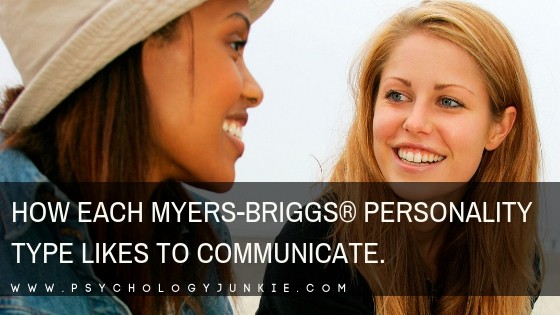How Each Myers-Briggs® Personality Type Likes to Communicate
Have you ever felt completely lost in communication with another Myers-Briggs personality type? Do you ever feel like your way of communicating is clashing with someone you truly care about? I often get asked about MBTI® and communication styles, and how one impacts the others. In today’s article we’re going to discuss some of the small ways each type prefers to communicate. We’ll go over some basics like how to say hello and how to say goodbye. We’ll even touch on some simple gestures that keep the conversation going in a more pleasant manner. I hope these communication tips will be helpful! Let’s get started!
Not sure what your personality type is? Take our new personality questionnaire!

Table of contents
How Each Myers-Briggs® Personality Type Likes to Communicate
Some Simple Tips to Get Started
- Give introverts time to process information before expecting a reply.
- Let extroverts “think out loud” and process things externally.
- Understand that sensors prefer a more linear, sequential conversation format.
- Understand that intuitives tend to have a more circular, out-of-order conversation format.
- Sensors will want more factual, concrete data to back up claims.
- Intuitives are more likely to make inferences and extrapolate.
- Feeling types appreciate warmth, good manners, and tactfulness.
- Thinking types appreciate people who are direct, straightforward, and logical.
Personality Type and Interaction Styles
According to psychologist and typologist Linda Berens, each personality type belongs to one of four groups of interaction styles. These interaction style “groups” tell us how we approach people, how we are naturally organized, and how we show support and guidance. These four groups are shown below:
Get-Things-Going™ Interaction Style (Comprised of ENFPs, ESFPs, ENTPs and ESFJs).
Behind-the-Scenes™ Interaction Style (Comprised of INFPs, INTPs, ISFJs and ISFPs).
Chart-the-Course™ Interaction Style (Comprised of INFJs, INTJs, ISTJs and ISTPs).
In-Charge™ Interaction Style (Comprised of ENFJs, ENTJs, ESTJs, and ESTPs).
Each group of interaction styles contains one personality type from each of the four temperaments (for example, one NF Idealist, one NT rational, one SJ guardian, and one SP artisan). You can find out more about interaction styles and even become certified as a trainer in interaction styles at Linda Berens web site, Insterstrength™.
Communicating with ENFPs, ENTPs, ESFJs and ESFPs (Keep Scrolling for Other Types)

ENFPs, ENTPs, ESFJs and ESFPs have a “Get-Things-Going™” interaction style. This means that they enjoy persuading and involving other people in experiences and opportunities. They have an open energy and enjoy back-and-forth communication. They tend to be expressive and participative and they like a mutual swapping of ideas and plans. They inspire people to move towards action, exploring possibilities, options, and making preparations. In decisions they like everyone to have a voice and they want everyone to be actively engaged and enjoying themselves. People with this interaction style are usually good at finding out what other people need or want. They’re good at listening, asking questions, and clarifying what other people need. They view life as a constant, ever-transforming learning experience.
ENFPs – These types like to hypothesize, make inferences, and brainstorm. They are usually open-minded and enjoy meaningful, abstract conversation topics. They focus on the future, present, and past in random order.
ESFPs – These types like to experience, explore, and interact with the world around them in a hands-on way. They are “doers” who enjoy action and participation. They enjoy lively storytelling and authenticity. They focus more on the present than the past or future in most cases.
ENTPs – These types like to ask “What if?” questions and extrapolate about future possibilities. They focus more on logic and impersonal criteria when they decide and can appear more direct than the three other types in this group. They enjoy taking apart ideas and exploring potential. These types tend to focus on the future, present, and past in random order.
ESFJs – These types are warm, nurturing, and inclusive. They like to make sure everyone in the group is cared for and involved. They tend to be more organized than the three other types in this group. They are known for being grounded, pragmatic and traditional. These types tend to focus more on the past first, using that information to determine how present and future situations will unfold.
Some Basic Tips for Communicating with These Four Personality Types:
- Smile and make eye contact when saying hello.
- Use open gestures and keep your manner friendly and energetic.
- Ask open-ended questions and be responsive to their answers.
- With ENTPs and ENFPs, be prepared for some friendly debate and argument. Don’t take this personally.
- When explaining something, present the main points and allow time for plenty of conversation and questions.
- If you’re working on a project together, bring up shared interests as a way to keep the atmosphere pleasant and to show that you care.
- When answering questions or getting feedback, allow them to digress, extrapolate, and “think out loud”.
- Use storytelling and give personal examples when explaining something.
- Let them explore options before pressuring them to decide on anything.
- If you’re trying to convince them of something mention any components that would be fun or entertaining.
- When you say goodbye leave with a positive note. Show warmth and confirm that you enjoyed the visit.
- Understand that during tense moments people with this temperament tend to use humor to “break” the tension.
- Understand that when these types are stressed, they can become more loud, animated, and expressive. During extreme stress they can close up completely.
Find out more about these personality types:
Understanding ENFP Intuition, Understanding ENTP Intuition, Understanding ESFP Sensing, Understanding ESFJ Feeling.
Communicating with INFJs, INTJs, ISTJs, and ISTPs

INFJs, INTJs, ISTJs and ISTPs are all part of the “Chart-the-Course™” Interaction Style. This means that they have a focused, deliberate energy and prefer to work on one thing at a time. They put their energy towards anticipating and strategizing to achieve a desired result. People in this group always want to know where they’re going and how to get there. They tend to have a contained tension in their demeanor and they pour this tension into analyzing, outlining, conceptualizing, and foreseeing. Their focus is on gathering information and creating a process that will progress towards a singular goal.
INFJs – People of this type like to contemplate information after it’s been given. They like to get alone and envision how various possibilities could play out and then narrow down which possibility is the most likely or most beneficial for people. They are empathetic and warm and focus primarily on the future.
ISTJs – People of this type like to reflect on information after it has been given. They like to isolate the facts and details and figure out what course is the most logical and pragmatic. They are known for being grounded and matter-of-fact. They focus on the past and how it will impact the present and future.
INTJs – People of this type like to get alone in a quiet place to explore complex ideas and patterns. They want to foresee the most likely strategy to achieve a future goal. They focus primarily on the future and which patterns will provide the most optimal result.
ISTPs – People of this type are tactically intelligent and extremely independent. They combine action with analysis and are good at troubleshooting and thinking quickly in make-or-break situations. They’re skilled at coming up with resourceful, logical ways to reach more immediate goals. Of the four “Chart-the-Course™” types, ISTPs are the most in tune with the present moment.
Some Basic Tips for Communicating with These Four Personality Types:
- When greeting these types be sure to smile, but also give them personal space (unless you’re a significant other/family member).
- Make intermittent eye contact but don’t stare for too long.
- These types enjoy friendly banter and humor, but it can frustrate them when they’re trying to focus on a project.
- Don’t ramble if you need something from them.
- Don’t interrupt or use a lot of small talk when trying to get information.
- When you explain something, be detailed and pause for any questions they might have.
- Give them time to reflect before expecting an answer.
- Understand that they tend to be very focused on what they’re doing and can get thrown off by unrelated conversation.
- Don’t rush them. Understand that they will be careful and particular.
- In a work setting, make sure you let them know what progress you’ve made before you leave. Let them know things are under control.
- In a relationship setting, be specific about your desires and where you see the relationship going. Don’t be wishy-washy or vague.
- Understand that these types can go from friendly to distant if things get stressful. If life feels unplanned or directionless they can appear especially aloof and even critical.
- During conflict situations these types can become especially quiet and stoic. They usually process the conflict after it happens and then may come back with more emotion afterwards.
Find out more about these personality types: Here’s Why INFJs and INTJs Seem “Intense“, Understanding ISTJ Sensing, In-Depth ISTP Personality Profile.
Communicating with INFPs, INTPs, ISFJs and ISFPs

INFPs, INTPs, ISFJs and ISFPs all belong to the “Behind-the-Scenes™” Interaction style. People in this group have an open energy and enjoy taking in tidbits of data from all around them. They like scoping things out and integrating as much information as possible to make the best decision. They focus on getting the best result possible and understand that many contributions and viewpoints can help in that regard. When they approach people they tend to appear quiet and calm even if they have strong convictions about their standpoint on something. They are usually patient because they want to have the best information possible before they make a decision or refine a result.
INFPs – Imaginative and empathetic, INFPs enjoy insightful, meaningful conversation. They appreciate authenticity and open-mindedness and enjoy extrapolating about future possibilities with others. They tend to focus on the present, future, and past in random order.
INTPs – Creative and curious, INTPs enjoy gathering as much information as possible before making a decision. They are good at thinking outside-the-box and experimenting to get the best result. They tend to focus on the present, future, and past in random order.
ISFJs – Pragmatic and empathetic, ISFJs enjoy discussing realistic ways to help people and get their needs met. They also enjoy creating comfortable, soothing environments where everyone feels at ease and healthy. They tend to focus on the past and how it influences the present and future.
ISFPs – Realistic and idealistic, ISFPs enjoy taking action to create a better world. They are usually quiet and thoughtful, but quick to respond to crisis situations. Of the four “Behind-the-Scenes™” personality types, ISFPs are the most in tune with the present moment.
Some Basic Tips for Communicating with these Four Personality Types:
- When saying hello use a quiet and friendly tone.
- Be laid-back and don’t take yourself too seriously.
- Use a steady, calm pace and don’t rush.
- When getting information don’t rush them or interrupt.
- Take regular pauses. Don’t dominate the conversation.
- Nod your head to confirm that you understand what they are saying.
- When you’re explaining something give them time to process and reflect on what you’ve said.
- Ask them about their thoughts on a subject and actively listen.
- When working on a project together be helpful. Understand that they might want more information than you will (if you have a different interaction style).
- Don’t finish their sentences. They hate this.
- Be honest and open.
- If they need your help with something assure them that they’re not bothering you.
- Be supportive.
- When saying goodbye be sure to end the conversation on a friendly note.
- In prolonged stressful situations these types can become uncharacteristically angry and critical. This is usually rare. Be understanding.
- These types care more about quality than speed. They like to rework, revise, and reconsider things. Be patient with this.
- These types can get embarrassed by public recognition and compliments.
Find out more about these personality types: Here’s Why INFPs and INTPs Get Misunderstood, ISFP Personality Profile, ISFJ Personality Profile.
Communicating with ENFJs, ENTJs, ESTJs and ESTPs

ENFJs, ENTJs, ESTJs and ESTPs belong to the “In-Charge™” interaction style. People in this group have a determined energy and usually have a commanding presence that conveys a sense of having things under control. “In-Charge™” types like to accomplish things and get achievable results. People of this interaction style are good at keeping themselves and others on task, on target, and ready for action. They enjoy mentoring, executing actions, and mobilizing resources to get goals accomplished. They are extremely aware of inefficiencies and have no problem correcting things that are getting in the way of their desired outcome.
ENFJs – Warm and visionary, ENFJs are the most people-oriented of the four “In-Charge™” personality types. They like to mobilize people and discuss personal growth and human potential. They are more focused on the future than the past or present.
ENTJs – Determined and insightful, ENTJs like to work hard to achieve progressive goals. They tend to use metaphor and symbolism in their speech and they like people who think outside-the-box and have big ambitions. They are more focused on the future than the past or present.
ESTJs – Pragmatic and grounded in reality, ESTJs focus on facts and enjoy discussing things in a linear, sequential fashion. They are detail-oriented and pride themselves on their observant attitude. They focus more on the past and how that influences the present and future.
ESTPs – Quick-acting and confident, ESTPs focus on finding solutions in make-or-break situations. They enjoy leading a team and being physically active and engaged in the world around them. They like storytelling and humor and enjoy friendly banter. Of all four “In-Charge™” personality types, ESTPs are the most tuned in to the present moment.
Some Basic Tips for Communicating with These Four Personality Types:
- Be brief and cordial when saying hello.
- Make direct eye contact.
- Speak quickly and with confidence.
- State directly what you want and why you’re there.
- When getting information be clear and matter-of-fact.
- When explaining something stay focused on the goal.
- Give the reason for your particular proposal or idea.
- Present the main points of your idea and don’t get carried away with excessive details.
- When you’re working together be efficient and purposeful.
- If someone of this style asks you a question and you don’t know the answer, let them know you’ll get the answer ASAP.
- Try not to procrastinate or go off on tangents unrelated to the main topic.
- If you know what they mean don’t extrapolate on other potential meanings. This feels like a waste of time to them.
- Don’t be wishy-washy or vague and don’t procrastinate.
- Understand that these types can become bossy when stressed. Help them to see that something is being done and use humor to help lighten the mood.
- When you say goodbye, honor their time and don’t dilly-dally. In a work relationship let them know things are under control.
- With ENFJs be friendly and warm when saying goodbye.
Find out more about these personality types: Here’s What ENFJs, ENTJs, ESTJs and ESTPs All Have in Common.
What Are Your Thoughts?
Did you enjoy this article? Do you agree or disagree with the advice? Let us know in the comments! Want to learn more about interaction styles or become certified as an interaction styles trainer? Check out Linda Berens web site at Interstrength.org














Your website is simply wonderful and I love the effort you put in it 🙂
Thank you!!
Very informative.
I NEEDED this growing up.
Because I talk too much!!!
I can’t help it … I’ve been in trouble since Kindergarten!
I just LOVE the gift of gab, but others get SICK of it.
So.
I can LITERALLY RECOGNIZE family, friends & former co-workers including superiors!!!
Man … So IMPORTANT is this article, especially for someone like me!
WoW.
I’m going to have to READ & RE-READ many times to “glean” as much as can, until I practically have this information MEMORIZED.
A B-I-G Thank You.
I’ve sabotaged myself too many times.
It’s “cute” when you’re young … But at 57, not so much.
Have a blessed year!!!
Caroline K. Newble
Thank you for this article, it’s really helping me understand my ISTP protagonist.
And thank you for this website overall. Your articles are so well researched and thought out. I’m also impressed with how well you represent each type and the cognitive functions well; that’s surprisingly hard to find in the MBTI community. Kudos to you!
(Also because I discovered the cognitive functions through your website and those articles along with many of your others convinced me that I’m an ISFJ, not an ENFJ, and then everything made much more sense. 🙂 Thank you!)
Susan-This is such an amazing wealth of information you have put together! I am an ESTJ
and my fiance is an ISFJ
and I find that sometimes we can have a difficult time communicating simply based on our delivery. I sincerely appreciated your section on how to communicate with other MBTI types. The world would be a kinder place if everyone could understand that different personality types have different communication styles. Thanks for posting!
So much interesting information. I enjoy reading and thinking about everything. Sometimes I have to re-read it, but I truly find it fascinating.
Susan, I feel that your work adds understanding, depth and greater value to my use of MBTI. Thank you!!! Harry
ENFJ
Thank you so much Harry!!